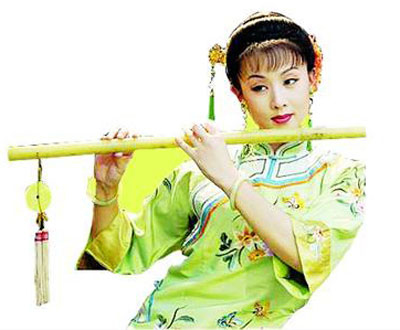

Huangmei Opera
The instrumental music in Cantonese Opera is a combination of percussion and orchestral music. The percussion section of Cantonese Opera consists of many different drums. The percussion is responsible for the overall rhythm and pace of the music.
The orchestral part of Cantonese opera music provides an accompaniment to the singing, and provides both precludes and interludes. Today, Cantonese opera has incorporated many western instruments including the cello, the saxophone, and even the violin.
Cantonese opera shares many common characteristics with other Chinese theatrical genres. It is characterized by a combination of string and percussion instruments, with elaborate costumes and face painting.
It also incorporates stunts and fights using real weapons, drawing inspiration from the Shaolin martial arts, as illustrated by the central Wenwusheng role that demands proficiency in both singing and fighting.
While actors are singing and moving around on stage, they also have to act. The art of acting during a Cantonese opera performance is not the same as acting in movies or on TV. Many emotions have specific facial expressions and body gestures which must be performed. Performers also have to be careful not to ruin their makeup or hair with histrionic expressions.
Many Cantonese operas preach the importance of being loyal to one's country, filial to one's parents, and kind to one's friends. The art form has developed a rich repertoire of stories ranging from historical epics to more realistic descriptions of daily life. The culture and philosophy of the Chinese people are also reflected in the plays. So, Cantonese opera not only entertains, but also plays a significant part in cultivating good values.
黄梅戏 Huangmei Opera (huáng méi xì )
Huangmei Opera was originally called "Huangmei tunes" or "tea-picking opera," and it combines singing and narration to tell stories in a local dialect.
This folk opera originated at the end of the 18th century and Anqing city in southwest Anhui is considered the birthplace of this opera style.
Compared to large opera productions, mini-operas are ever more popular. Mini-operas usually have only 2 or 3 roles. In its early stages, all the melodies derived from folk songs. There are about 100 such melodies which are all called Huaqiang Flowery Tune in Huangmei Opera.
Talking about the characteristics of the Huangmei Opera, Pan Qicai, a famous Huangmei Opera artist, says:
"I summarize it in four sentences. The lyrics are vivid and popular. The music is beautiful and smooth. The repertoire is rich and varied. The performance includes singing and dancing. Especially the lyrics and the music or tunes, have strong local characteristics and artistic appeal."
It is said that life is played out on the small stage. The stage is a world unto itself, which reflects the even greater pageant of human life. Many rich and wonderful stories, some of which are over a thousand years old, are told in various forms of Chinese Opera. Young Chinese people today are still moved by the sorrows and joys expressed in these old operatic tales. From its humble birth to a glorious today, Huangmei Opera has experienced ups and downs. But one theme remains the same: life is beautiful.
Copyright ©1999-2018
Chinanews.com. All rights reserved.
Reproduction in whole or in part without permission is prohibited.